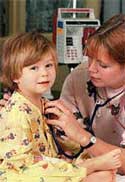Nursing &
Allied Health Occupational Outlook ��
Health Services
- Health services is one of the largest industries in the country, with more
than 11 million jobs, including the self-employed.
- About 13 percent of all wage and salary jobs created between 2000 0and 2010 will be in health services.
- Nine out of 20 occupations projected to grow the fastest are concentrated in health services.
- Most jobs require less than 4 years of college education.
Combining medical technology and the human touch, the health
services industry administers care around the clock, responding to the needs of
millions of people�from newborns to the critically ill.
More than 469,000 establishments make up the health services industry; all vary greatly in terms
of size, staffing patterns, and organizational structures. Two-thirds of all
private health services establishments are offices of physicians or dentists.
Although hospitals constitute less than 2 percent of all private health
services establishments, they employ nearly 40 percent of all workers. When
government hospitals are included, the proportion rises to 45 percent of the
workers in the industry.
The health services industry provided more than 11 million wage
and salary jobs in 2000. Almost one-half of all salaried health services jobs were
in hospitals; another one-third were in either nursing and personal care
facilities or offices of physicians including osteopaths. About 91 percent of
wage and salary jobs were in the private sector; the remainder, in State and
local government hospitals.
In 2000, there were about 383,000 self-employed workers in the
health services industry. Of these, more than two-thirds were in offices of
physicians, dentists, and other health practitioners. Health services jobs
are found throughout the country, but are concentrated in large States,
specifically California, New York, Florida, Texas, and Pennsylvania.
Workers in health services tend to be older than workers in other
industries. They are also more likely to remain employed in the same occupation
due, in part, to the high level of education and training
required for many health occupations.
 Professional
occupations such as physicians and surgeons, dentists
registered nurses, social workers, and physical therapists, usually require at least a
bachelor�s degree in a specialized field or higher education in a specific
health field, although registered nurses also enter through associate
degree or diploma programs. Professional workers often have high levels of
responsibility and complex duties. They may supervise other workers or conduct
research, as well as provide services.
Professional
occupations such as physicians and surgeons, dentists
registered nurses, social workers, and physical therapists, usually require at least a
bachelor�s degree in a specialized field or higher education in a specific
health field, although registered nurses also enter through associate
degree or diploma programs. Professional workers often have high levels of
responsibility and complex duties. They may supervise other workers or conduct
research, as well as provide services.
Other health professionals and technicians work in many fast
growing occupations, such as medical records and health information technicians
and dental hygienists.
These workers may operate technical equipment and assist health
diagnosing and treating practitioners. Graduates of 1- or 2-year training programs often fill these positions; these
jobs usually require specific formal training beyond high school,
but less than 4 years of college.
Most jobs in health services provide clinical services, but there
also are
many in occupations with other functions as well. Numerous workers in
management and administrative support jobs keep organizations running smoothly.
Although many medical and health services managers have a
background in a clinical specialty or training in health services administration,
some enter these jobs with a general business education.
Employment in the health services industry is projected to increase
26 percent through 2010, compared to an average of 15 percent for all
industries. Employment growth is expected to add about 2.8 million new jobs.
To view the occupational outlook for RNs and LPNs, Nursing
Assistants and related professions, click on the links below. Information
provided includes the nature of the work; working conditions; employment opportunities;
training, other qualifications and advancement; job outlook; earnings
potential; related occupations; and sources of additional information.
PLEASE NOTE: The material in this publication is within the public
domain and has been reprinted here from the Occupational Outlook Handbook
(Division of Occupational Outlook, Bureau of Labor Statistics, U.S. Department
of Labor, Washington, DC 20212 Phone: (202) 691-5700. Fax: (202) 691-5745. E-mail:
[email protected].) To view other articles from the Occupational Outlook Handbook,
please visit the
BLS.
Find this
article at:
http://www.medi-smart.com/outlook.htm
DISCLAIMER: THE LINKS TO
OTHER SITES ARE PROVIDED ON THIS WEBSITE STRICTLY FOR INFORMATIONAL PURPOSES.
KEISER COLLEGE HAS NO AFFILIATION WITH THESE SITES AND NO REPRESENTATION IS
MADE AS TO THEIR CONTENTS OR THE INFORMATION CONTAINED THEREIN. OCCASIONALLY,
LINKS MAY NOT BE WORKING AND KEISER COLLEGE SHALL HAVE NO LIABILITY DUE TO
THEIR OPERATION. LINKS WERE LAST UPDATED ON 8/26/04.